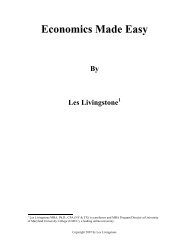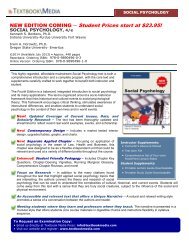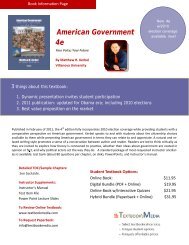Book Information / Sample Chapter(s) (PDF) - Textbook Media
Book Information / Sample Chapter(s) (PDF) - Textbook Media
Book Information / Sample Chapter(s) (PDF) - Textbook Media
Create successful ePaper yourself
Turn your PDF publications into a flip-book with our unique Google optimized e-Paper software.
68 <strong>Chapter</strong> 4 Demand and Supply<br />
Exhibit 4-5 Some Factors That Shift Demand Curves<br />
The left-hand panel (a) offers a list of factors that can cause an increase in demand from D 0<br />
to D 1<br />
. The right-hand panel (b)<br />
shows how the same factors, if their direction is reversed, can cause a decrease in demand from D 0<br />
to D 1<br />
. For example,<br />
greater popularity of a good or service increases demand, causing a shift in the demand curve to the right, while lesser<br />
popularity of a good or service reduces demand, causing a shift of the demand curve to the left.<br />
Taste shift to greater popularity<br />
Population likely to buy rises<br />
Income rises (for a normal good)<br />
Price of substitutes rises<br />
Price of complements falls<br />
Future expectations<br />
D 1<br />
encourage buying<br />
D 0<br />
Taste shift to lesser popularity<br />
Population likely to buy drops<br />
Income drops (for a normal good)<br />
Price of substitutes falls<br />
Price of complements rises<br />
Future expectations<br />
D 0<br />
discourage buying<br />
D 1<br />
Price<br />
Price<br />
Quantity<br />
(a) Factors that increase demand<br />
Quantity<br />
(b) Factors that decrease demand<br />
production fall, a firm will supply a higher quantity at any given price for its output, and<br />
the supply curve will shift to the right. Conversely, if a firm faces an increased cost of<br />
production, then it will earn lower profits at any given selling price for its products. As<br />
a result, a higher cost of production typically causes a firm to supply a smaller quantity<br />
at any given price. In this case, the supply curve shifts to the left.<br />
As an example, imagine that supply in the market for cars is represented by S 0<br />
in<br />
Exhibit 4-6. The original supply curve, S 0<br />
, includes a point with a price of $20,000 and<br />
a quantity supplied of 18 million cars, labeled as point J, which represents the current<br />
market equilibrium price and quantity. If the price rises to $22,000 per car, ceteris<br />
paribus, the quantity supplied will rise to 20 million cars, as shown by point K on the<br />
S 0<br />
curve.<br />
Now imagine that the price of steel, an important ingredient in manufacturing cars,<br />
rises, so that producing a car has now become more expensive. At any given price for<br />
selling cars, car manufacturers will react by supplying a lower quantity. The shift of<br />
supply from S 0<br />
to S 1<br />
shows that at any given price, the quantity supplied decreases. In<br />
this example, at a price of $20,000, the quantity supplied decreases from 18 million<br />
on the original supply curve S 0<br />
to 16.5 million on the supply curve S 1<br />
, which is labeled<br />
as point L.<br />
Conversely, imagine that the price of steel decreases, so that producing a car becomes<br />
less expensive. At any given price for selling cars, car manufacturers can now expect<br />
to earn higher profits and so will supply a higher quantity. The shift of supply to the<br />
right from S 0<br />
to S 2<br />
means that at all prices, the quantity supplied has increased. In this<br />
example, at a price of $20,000, the quantity supplied increases from 18 million on the<br />
original supply curve S 0<br />
to 19.8 million on the supply curve S 2<br />
, which is labeled M.<br />
Factors That Shift Supply Curves<br />
A change in any factor that determines what quantity firms are willing to sell at a<br />
given price will cause a change in supply. Some factors that can cause a supply curve<br />
to shift include: changes in natural conditions, altered prices for inputs to production,<br />
new technologies for production, and government policies that affect production costs.













